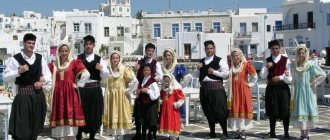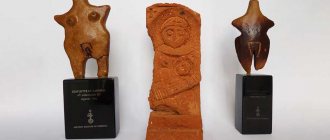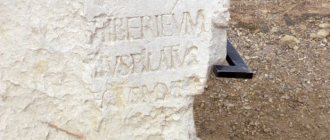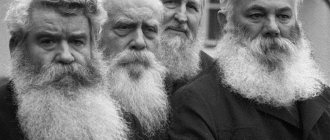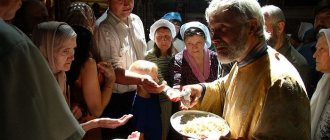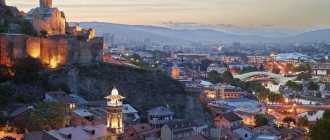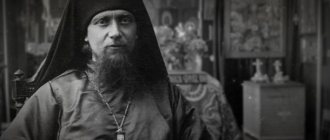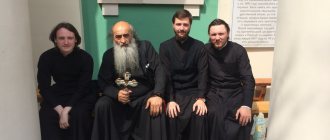Create to PDF
The Ethiopian Church was the only state church in the East that remained intact from early times until the end of the twentieth century, when it was separated from the secular state by a revolutionary decree in 1974. With a population of at least 12 million, it still exists. the largest autocephalous Christian institution in Africa. During its sixteen hundred year history, it has not only survived devastating internal and external wars and divisions, but has also remained a stronghold of spiritual resources, formal education, indigenous culture, art and architecture for Ethiopian society.
The Ethiopian Orthodox Church has its own ritual and a special hierarchy of clergy
The Ethiopian Orthodox Church belongs to the Patriarchate of Alexandria. Its center is in Addis Ababa. Until 1959, it was considered an autonomous church and was canonically dependent on the Coptic Church. Then she received autocephaly.
The Ethiopian Orthodox Church is one of the pre-Chalcedonian churches.
Ethiopian Orthodox Church. Holy Trinity Cathedral in Addis Ababa. The Ethiopian Orthodox Church is one of the pre-Chalcedonian churches. Its center is located in Addis Ababa
The church is part of the Ancient Eastern (pre-Chalcedonian) churches. In this capacity it recognizes three Ecumenical Councils. It is unique in that it professes a Multiphysite Christology.
She has her own ritual, original. Also, its hierarchical structure of the clergy has no analogues.
Video: Monophysitism. What is this? Author: Archpriest Vladimir Golovin. Briefly answering questions from believers, he says that according to the Monophysite heresy, Jesus Christ is God, but not a man.
Christian Ethiopians recognize some of the commandments of the Old Testament. Most modern Christians consider them irrelevant. Among them, for example, is the observance of food prohibitions characteristic of the Old Testament.
In addition, Ethiopians also practice male infant circumcision. This ritual is performed on the eighth day, in full accordance with the commandments of the Old Testament.
Organizational structure and hierarchy
The spiritual head of the Ethiopian Orthodox Church was abun, which traditionally was to be a Coptic ordained by the patriarch of Alexandria. However, an Ethiopian acceded to the metropolitanate for the first time in 1951 and was promoted to the status of patriarch in 1957, in accordance with the diplomatic arrangements made between the Ethiopian Government and the Throne of Alexandria (see ETHIOPIAN CHURCH AUTOPHALY). The equivalent of the abun was always an Ethiopian dignitary of one of the prominent monasteries who presided over the general administrative affairs of the church. In the last four or five hundred years, this office was dominated by the CC era of Dabra Libanos, who acted as a liaison between church and state and as a judge of record cases. Its role at the national level diminished with the creation of the Beta Kehnat (the central office of church administration) in the twentieth century.
In terms of internal governance, churches and monasteries have always been autonomous, each belonging to the community that founded and supported it. Therefore, their material well-being was barely uniform until the Provisional Military Council nationalized all land holdings by decree in 1975. The churches were grouped under two heads. First there were adbarats (Sing. dabr), usually located in monasteries and large public centers; they were full-fledged churches, enjoying the rights and privileges granted to them over the centuries, and more or less owning land, animals, schools and libraries. They were often well staffed with priests, deacons, musicians, and teachers, all headed by priests. The alaka (dean) is appointed by the sovereign or his representative or elected by his society. Another group consisted of gatarmala churches, staffed by five or seven clergy and serving small communities remote from the dabras which had jurisdiction over the area. Any of the gathara of the church can, under special circumstances, develop into a dabr.
Ethiopians descend from King Solomon and the Queen of Sheba
Ethiopians trace their ancestry back to King Solomon and the Queen of Sheba. The Queen of Sheba is revered as the mother of Menelik I, the first ruler of Ethiopia. Semitic settlers have been penetrating the country for a long time.
They did not have a great influence on life in the country, but thanks to them, Christianity in it received original features.
It should be noted that Amharic is recognized as the official language in Ethiopia. Divine services are also held there.
The Queen of Sheba rides to Jerusalem. Ethiopian fresco. Ethiopians revere the Queen of Sheba as the mother of Menelik I, the first ruler of Ethiopia.
Eusebius Pamphilus and the New Testament claim that Christianity was brought to Ethiopia by the Apostle Philip.
He baptized the eunuch Aetius, who served at the court of Queen Kadakia. Aetius became the enlightener of Ethiopia (Acts of the Holy Apostles 8:26-30).
Saint Frumentius finally established the Christian faith in these places.
Saint Frumentius became bishop around 347.
The saint came from Tire and had Roman citizenship. His ship was shipwrecked on the African coast of the Red Sea. Having gained the trust of the Ethiopian emperor Aksum, he converted his son Ezana to Christianity.
When he became emperor, he declared Christianity the state religion in 330. Around the year 347, Saint Athanasius of Alexandria ordained Saint Frumentius bishop of the city of Ascum.
Video: Lives of the Saints St. Frumentius, Archbishop of India (Ethiopia). The film gives a brief retelling of the life of Saint Frumentius, the enlightener of Ethiopia.
See also the article Religion of Armenians
It should be noted that Saint Frumentius was in the position of a prisoner at the king’s court, but before his death he decided to release Frumentius to his homeland.
Despite this, after the death of Aksum, the saint returned to Ethiopia in order to continue its evangelization.
Education and literature
For centuries, the church was the only Christian institution that sponsored formal education in Ethiopia. In principle, schools were open to both sexes, although male students always formed the majority. Basic education consisted of reading and to some extent writing, as well as reciting the Lord's Prayer, the Nicene Creed and the Hail Mary, and repeating passages or the entire Psalter. Relatively few entered higher education, which were divided into three faculties: Ken Beth (the school of poetry), in which one can study grammar, comparative history and various aspects of poetry; Zema Bet (music school), which offered the complex compositions of the Aksumite Saint Yared and his successors; and tergum bet (school of interpretation), where one could study the Holy Scriptures, the works of the ancient fathers, church and civil laws.
The Bible of the Ethiopian Orthodox Church consists of forty-six books of the Old Testament and thirty-five books of the New Testament, for a total of eighty-one books. Various books of the Bible were translated into Ge'ez at various times before the end of the seventh century of the Christian era from the Septuagint and Syriac versions. In addition to translations of various works from Greek, Syriac, Arabic and possibly Coptic, a number of hagiographies, eulogies and commentaries were published in the country itself.
ETHIOPIAN LITURGY is based on the Holy Scriptures and the compositions of the early fathers, and the congregation participates in all celebrations. The mass is said by a minimum of five celebrants—three priests and two deacons. In its teachings, the church gives due attention to the seven mysteries: baptism, the Eucharist, confession of sin, resurrection of the dead, marriage, priesthood and exclusive anointing. The latter is practically never practiced. The fasts of Nineveh, Lent, the Apostles, the Dormition of the Virgin Mary and the Prophets are observed, as well as the birth, crucifixion, resurrection and ascension of Christ, as well as Pentecost, St. John's Day or New Year's Day and Nativity of Christ. Saint
The Cross is one of the main holy days, celebrated with elaborate church services.
Ethiopia did not accept Arianism, but became Monophysite
Ethiopia was influenced by the Arius heresy. Its spread in the state was stopped by Saint Athanasius the Great. The fathers of the First Ecumenical Council also fought against Arianism in Ethiopia.
That is why one of the fourteen liturgical anaphoras is dedicated to Athanasius the Great, while the other 318 are dedicated to the fathers of the First Ecumenical Council in Nicaea.
Trinity. Ethiopian icon. Despite the fact that the Ethiopians rejected the heresy of Arius, they accepted, following the example of the Copts, the Monophysite heresy
Despite the fact that the Abyssinians (Ethiopians) remained faithful to Orthodoxy, in the 6th century they fell away from the union with the Universal Church.
This happened because there have long been disputes about the Holy Trinity on Ethiopian soil. Because of this, the Ethiopian Orthodox Church adopted the Monophysite heresy, following the example of the Copts.
See also the article Arianism
Rituals and holy places of Ethiopia
Most holidays are religious in nature. The dominant religion in Ethiopia, Orthodoxy, obliges the observance of Christian holidays - Christmas on January 7, Epiphany (celebration of the baptism of Jesus) on January 19, Good Friday and Easter (late April), Meskel (finding of the true cross) on September 17.
Muslim holidays include Ramadan, Eid al Adha on March 15, and Muhammad's birthday on June 14. The basis of all religious holidays is the worship of believers in holy places. Many Christian Orthodox holidays are public holidays.
The arrival of the "Nine Saints" finally established Christianity in Ethiopia.
After Saint Frumentius, Bishop Mina led the church in Ethiopia. It was from this moment that Alexandria's special jurisdiction over her began. This continued for sixteen centuries.
Three of the "Nine Saints" (from left to right: Abuna Tzahama, Abuna Imata, Abuna Alaf) - an 18th-century fresco in a church in Gralata, Tigre. The "Nine Saints" are revered in Ethiopia along with Saint Frumentius for the contributions they made to the spread of Christianity in Ethiopia
Separately, it is necessary to note the contribution that the “Nine Saints” made to the spread of Christianity in the country.
They arrived in the country in 480 from Rome, Constantinople and Syria with the aim of conducting missionary activities in it.
It is believed that these were opponents of Chalkildon, which is why they left their hometowns, hiding from the persecution of the Byzantine emperor who received him. Saints' names:
480
this year the "Nine Saints" arrived in Ethiopia
- Aragavi;
- Panteleimon;
- Karima;
- Alaf;
- Seham;
- Afse;
- Liganos;
- Adimata;
- Oz, or Cuba.
The saints lived for some time before moving to Ethiopia in the monastery of St. Pachomius in Egypt. Under their influence and the influence of the Coptic Church, the Ethiopian Church rejected Chalcedon.
The saints created a monastic tradition in the country, put an end to the remnants of paganism, and translated the Bible and other religious literature into classical Ethiopian.
Monastery of St. Pachomius the Great. Egypt. Our days. The “Nine Saints” lived here for some time before coming to Ethiopia
Orthodoxy in Ethiopia reached its peak in the 15th century. It was then that talented theological and spiritual literature was written. In addition, at this time the Church was actively engaged in missionary activities.
Unfortunately, in 640 - 642, all of Christian Africa was conquered by Muslims, and for almost a decade Christianity in Ethiopia was in decline.
Architecture and painting
The church was also an Ethiopian institution, the richest in architecture and painting. Due to the political circumstances that prevailed in the country for centuries, very few secular structures were built after the Aksumite era. Instead, much investment was made in churches, thousands of which were built and rebuilt, and decorated with paintings and ornaments. Most church buildings are round, although some of the oldest are rectangular or even polygonal in shape. Each church is divided into three parts, each with a specific purpose. Entering from the porch, one reaches the Kene Mahlet (choir), separated from the inner circle by a wall concentric with the outer wall. This passenger-like room extends around the entire building and is intended for the laity, as well as for the ritual dancing and singing of the clergy.
Several doors lead to an inner circular room known as the maqdas (sanctuary), where mass is celebrated. Lay members enter it primarily to receive Holy Communion. At the center of the maqdas is a square room, also divided by walls and known as Qeddesta Qeddusan (holy of holies). It can be entered through a small entrance and only the celebrant Priests can enter it. The tabot (Ark of the Decalogue) and sacred books are kept here. Almost all the walls are covered with paintings depicting motifs from the Holy Scriptures, the lives of saints and martyrs, and details from the history of Ethiopia. Many parchment books are also illustrated and decorated.
The Ethiopian Church did not have independence for a long time
Orthodox Ethiopians did not have an independent Church for a long time.
The fact is that monasticism is developed in the country, but the church hierarchy has never developed, since the Ethiopian Church from the moment of its creation was considered one of the dioceses of the Coptic Patriarch of Alexandria.
The Patriarch always appointed Abuna as the only bishop of Ethiopia.
Haile Selassie with Abuna Basilios. From the time of his appointment as Ethiopian abuna until the 1974 revolution, the church gave full support to the emperor. Thanks to Emperor Haile Selassie in 1951, the Ethiopian Orthodox Church became independent
Abuna translated means “our father”, in addition, the head of the Ethiopian Church is also called “papas”. In the 12th century, Abuna Negus Sinuda tried to gain the right for Ethiopia to ordain several bishops.
This would make it possible to gain autonomy, since as a result a Synod would be formed, which would be endowed with the authority to elect Abuna. Seeing this, the Patriarch of Alexandria did not give his consent to grant autonomy to the Ethiopian Church.
1951
this year the Ethiopian church received autonomy
Emperor Haile Selassie, who ruled from 1930 to 1974, played an important role in gaining independence for the Ethiopian Church.
He held the rank of deacon. In 1948, with his help, it was possible to reach an agreement with the Copts to elect a local Ethiopian metropolitan after the death of Metropolitan Kirill.
This happened in 1951, when the Ethiopian Basil became metropolitan or abuna. This date is considered to be the date the Ethiopian Church gained autonomy. Eight years later, the Coptic Patriarchate confirmed Metropolitan Basil as the first Patriarch of the Ethiopian Church.
Abuna Saviros, ychege - head of the monasticism of the Empire. As in many cases before, so now ychege, the head of the monastics, was the right hand of the emperor. He enjoys great influence, since the management of all church affairs is in his hands
It should be noted that the second place in the hierarchy of the Ethiopian Church is occupied by echege. This is the head of the black clergy.
He is the archimandrite-dean of all monasteries. He does not have the rank of bishop, but he enjoys great influence, since the management of all church affairs is in his hands.
After him come representatives of the white clergy. In this case, church administration is entrusted to various persons of clergy who do not have holy orders.
That is why one church can sometimes have several dozen priests and deacons.
Church at the ends of the earth. Part 1
These essays are an attempt to combine some historical information and facts about the Ethiopian Church with the small experience that I had from meeting this Church during a visit to Ethiopia in June 2006 with my colleague Father Alexander Vasyutin. Anyone who wishes to write about the Ethiopian Church will not be a pioneer. However, probably not everyone who wrote about this Church, at least in Russian, had the opportunity to directly come into contact with the living tradition of this Church - Ethiopia remains one of the least accessible countries in the world. These notes may be subjective in nature - especially in the part that concerns the description of the current state of the Church. However, such subjectivity is inevitable, especially if we take into account that I was able to observe only a few aspects of the life of the Church during just five days of my stay in it.
Story
Church of St. George (Lalibela, 12th century), carved into solid rock
/p>
So first, some facts and history. The self-name of the Ethiopian Church is the Ethiopian Orthodox Church of Tewahedo.
.
Tehuahedo
means "united" and is essentially a theological formula that denotes the way in which the Divinity and humanity are united in Christ. The Ethiopian Church is the only one that uses a theological formula in its self-name. It is the largest of all the Churches of the pre-Chalcedonian tradition, but also the most isolated - primarily due to the geographical remoteness of Ethiopia. The Ethiopian Church is also one of the most ancient Christian Churches. She herself traces her origins to apostolic times, when the eunuch of the Ethiopian queen Candace was baptized by the Apostle Philip (Acts 8: 26–30). However, at that time the name Ethiopia did not refer to present-day Ethiopia, but to Nubia in modern-day Sudan. Only after in Aksum in the second century A.D. The Solomonid dynasty reigned, and this name was adopted for the country. Along with this name, another was used - Habasha or, in its Hellenized form, Abyssinia.
Ethiopia is made up of many ethnic groups, the largest of which are the Oromos, Amharas and Tigrayans. Some Ethiopian peoples are of Semitic origin, and such Ethiopian people as the Falasha still profess Judaism. According to an ancient Ethiopian legend described in the book "The Glory of Kings" ( Kebre Negest
, XIII century), the first royal dynasty of Ethiopia - the Solomonids - traced their origins to King Solomon and the Queen of Sheba. However, this legend cannot be confirmed by historical data.
Ethiopia became one of the first countries in which Christianity was established as a state religion. According to Rufinus, the Aksumite rulers were converted to Christianity by Saint Frumentius, the son of a Syrian merchant who was shipwrecked in the Red Sea and enslaved in Aksum. Here he began to preach the Gospel and was eventually able to become the teacher of the heir to the kingdom of Aksum. Having received his freedom, he left for Alexandria, where Saint Athanasius of Alexandria was ordained bishop for the newly formed Ethiopian Church. Here he converted the Aksumite king Ezan to Christianity. Saint Frumentius thus became the enlightener of Ethiopia. No wonder the Ethiopians call him “Father of the World” and “Discoverer of Light” ( Abba Salama, Kassate Berhan
).
Abuna Basil kissing the ring of Emperor Haile Selassie
/p>
As a result of the missionary activity of Saint Frumentius, the Ethiopian Church for many centuries found itself in the sphere of influence of the Alexandrian bishops, who until recently played a vital role in the life of this Church, providing it with metropolitans and bishops. Until the middle of the 20th century, the Ethiopian Church did not have bishops of Ethiopian origin, but exclusively Coptic ones. In the life of the Ethiopian Church, secular power traditionally played an important role - even to a greater extent than was customary in Byzantium. An illustrative example is that until recently, secular persons were often appointed abbots of the largest monasteries, as well as abbots of the historical Aksum Cathedral.
Secular rulers, together with the Church, contributed in every possible way to the Christianization of Ethiopia, although they failed to completely convert the entire country to Christianity. Back in the 7th century, the first Islamic communities formed in Ethiopia, and now the Islamic population of the country is even slightly larger than the Christian population. Also, paganism has always been preserved in Ethiopia, and tribes of pagan anemists still live in the south of the country. The history of the Ethiopian Church was very turbulent in the 16th century, when Ethiopia was first invaded by the Muslim conqueror Ahmed Grang (1529–1543), and then the Jesuits arrived with the Portuguese army, who, under Emperor Susneyos (1508–1532), managed to achieve a short-term union of the Ethiopian Church with Rome. The union did not last long and ended in a bloody civil war. The Jesuit mission was eventually expelled from Ethiopia by Emperor Fassiladas in 1632. At the same time, the German missionary Peter Heiling arrived in Ethiopia with a Protestant mission. His mission also eventually ended in the exile of the preacher from the country. The activities of Western missionaries led to the fact that the Ethiopian Church, trying to protect itself from foreign influences, closed itself to the outside world and found itself in self-isolation. She has only recently begun to renew contact with the outside world.
The main building of the Ethiopian Patriarchate
/p>
Throughout all centuries of the history of the Ethiopian Church, beginning with the ordination of Saint Frumentius by Saint Athanasius of Alexandria, this Church was part of the jurisdiction of the Alexandrian Church (after the Council of Chalcedon - the Coptic Church). Throughout this time, Alexandria supplied bishops to Ethiopia and had complete control over the Ethiopian Church. However, from the beginning of the 20th century, the Ethiopian Church began to demand greater independence. As a result, the first four Ethiopian bishops were ordained for her in 1929 to assist the Coptic metropolitan. The first attempt to secede from the Coptic Church was made during the Italian occupation of Ethiopia (1935–1941) and was supported by the occupation authorities. The Copt Cyril, who was the Ethiopian metropolitan at that time, refused to sever relations with Alexandria, for which he was expelled from the country. Instead, Bishop Abraham, an Ethiopian by nationality, was appointed Metropolitan of Ethiopia. However, he was immediately deposed by the Coptic Church. After the war, an attempt to make the Ethiopian Church independent was made again, this time with the support of Emperor Haile Selassie (1930–1974). As a result of difficult negotiations in 1948, an agreement was reached with Alexandria on the election of an Ethiopian metropolitan from among the local hierarchs. When Metropolitan Kirill, who returned from exile, died in 1951, he was replaced by the Ethiopian Basil (Bazilos). In 1959, Alexandria confirmed Basil as the first Ethiopian Patriarch. Since that time, the Ethiopian Church has been considered autocephalous.
Emperor Hale Selassie
/p>
The independence of the Ethiopian Church was not easy for her. The last emperor of Ethiopia, Haile Selassie, played a decisive role in this, who essentially forced the Coptic hierarchy to make concessions. Haile Selassie was a great benefactor of the Ethiopian Church. He traced his ancestry back to the time of the Queen of Sheba and bore the loud title “Lion invader from the tribe of Judah, the chosen one of God, king of kings.” The very name he took upon his elevation to the imperial throne is Haile Selassie, meaning “Power of the Trinity.” He was ordained to the diaconate.
Haile Selassie was overthrown in 1974 by a military junta and died in Addis Ababa in 1975. The regime that seized power in Ethiopia was supported by the Soviet Union. Major Mengistu Haile Mariam, who headed it in 1977, initiated real persecution against the Church. Many churches and monasteries were closed, their property was taken away by the state, many bishops, priests and monks were thrown into prison, some were executed. Thus, in 1979, Patriarch Theophilus (Tevofilos), who was deposed in 1976, was killed. After the fall of the Mengistu regime in May 1991, Patriarch Mercury (Merkorios), who had headed the Ethiopian Church since 1988, was accused of collaboration and expelled from the country.
Priests Alexander Vasyutin and Sergius
/p>
On July 5, 1992, the synod of the Ethiopian Church elected Abuna Paul as the new patriarch, who still heads this Church. He is already the fifth patriarch of the independent Ethiopian Church. His full title: His Holiness Abuna Pavlos, Fifth Patriarch and Catholicos of Ethiopia, Echege of the Throne of Saint Takla Haymanot and Archbishop of Aksum ( Abuna
in Arabic means "our father";
the title of Catholicos
was borne by church primates outside Byzantium;
echege
- elder - means the head of monastic communities;
Takla Haymanot
is one of the largest monastic communities (houses) in Ethiopia;
Aksum
is the first historical see of the Ethiopian Church). Abuna Pavel was born in 1935 in Tigray province in the north of the country. This province is essentially the Christian core of Ethiopia. The family of the future patriarch was closely connected with the monastery of Abuna Gerima, where Paul entered the monastic life as a boy. Abuna Paul studied first in Addis Ababa, and then went to America, where he took a theology course at St. Vladimir's Seminary. There his teachers were Archpriest Alexander Schmeman, Archpriest John Meyendorff, and Professor S.S. Verkhovsky. After this, he entered the doctoral program at the no less famous Princeton Theological Seminary, but did not have time to complete it, as he was recalled to Ethiopia by the then Patriarch Theophilos - at that time a coup was just taking place in the country. These difficult years for the Ethiopian Church became a testing period for Paul as well. In 1975 he was ordained bishop by Patriarch Theophilus, who was soon afterwards removed from the see and then killed. Paul's ordination was not sanctioned by the authorities, and he was sent to prison, where he spent eight years. In 1983, Pavel was released from prison and left for the USA. Here he finally completed his doctorate at Princeton and continued his ecclesiastical career, being elevated to the rank of archbishop. During the change of power in Ethiopia, Paul returned to the country and was elected as the new patriarch.
The removal of Mercury from the patriarchal see and the election of Paul became a source of unrest in the Ethiopian Church. Mercury, who emigrated to Kenya, did not recognize the new patriarch. He was also not recognized by the Ethiopian Archbishop in the United States, Ezehak, who in 1992 interrupted Eucharistic communion with Addis Ababa. In response, the synod of the Ethiopian Church appointed a new archbishop in the United States, Matthias. Ezehak, however, refused to recognize this decision of the synod. As a result, the Ethiopian diaspora in North America was split - part of it remained loyal to Ezehak and never recognized Abuna Paul as the Ethiopian Patriarch.
Another serious problem that the Ethiopian Church has faced in recent years has been the self-proclamation of the Eritrean Church. The Eritrean Church separated from the Ethiopian Church after the formation of the independent state of Eritrea in 1991. This Church, largely under political pressure, was recognized by the Coptic Church, which appointed a patriarch for it.
Recently, tensions have also been growing in Ethiopia between Christians and Muslims, who currently outnumber Christians. In particular, a large Islamic community lives in Addis Ababa, where there are about 150 mosques compared to about 130 places of worship of the Ethiopian Church. Recently, Islam has increasingly strengthened its position in Ethiopia, receiving economic support from Saudi Arabia and the nearby Islamic countries of Somalia and Sudan. Many Ethiopians go to work in Islamic countries and either convert to Islam there or take Islamic names for themselves, becoming crypto-Christians.
Pagan communities remained in southern Ethiopia. Emperor Haile Selassie invited European Protestant missionaries to these regions in the mid-20th century to evangelize the pagans. As a result, Protestantism took root in the country, spreading mainly in the southern regions of Ethiopia, as well as in Addis Ababa.
Creed of the Ethiopian Church
Typical Ethiopian icon of the Holy Trinity
/p>
The Ethiopian Church has developed in special ways throughout its history. The path of its dogmatic development was also unique. Having received its historical existence from Saint Athanasius of Alexandria and being closely connected with the Alexandrian Church, the Ethiopian Church has always especially revered this Father of the Church. This is evidenced, for example, by the fact that one of the 14 anaphoras of the Ethiopian Church is attributed to Saint Athanasius. One of the most widely read works in the Ethiopian Church was the translation into Gyiz - the ancient Ethiopian language - of the life of St. Anthony, compiled by St. Athanasius of Alexandria. Another Ethiopian anaphora bears the name of the fathers of the Council of Nicaea, which is also especially revered in the Ethiopian Church. Ethiopian theology thus focuses on early dogmatic formulations and concepts associated with the name of St. Athanasius and the Council of Nicaea. Ethiopians are proud that they never accepted Arianism, even despite the fact that St. Athanasius was repeatedly expelled from his see and his place was taken by Arian bishops, and despite political pressure from the Byzantine emperors who supported Arianism. For comparison, it should be noted that the Goths, who received enlightenment at approximately the same time as the Ethiopians, accepted Christianity in its Arian version. Another father who has become an indisputable authority for the Ethiopians is another Alexandrian high priest - St. Cyril. It is noteworthy that one of the most important dogmatic collections in the history of the Ethiopian Church was named after St. Cyril of Alexandria - Kerlos
.
The Ethiopian Church, which throughout almost its entire history was in the orbit of the Coptic Church, did not accept the decision of the Council of Chalcedon. However, her doctrine of the Incarnation was finally formed relatively recently - in the 19th century. The impetus for this was the activity of Western missions - Catholic and Protestant, which posed a number of difficult questions to the Ethiopian Church about its theological identity. As a result, for more than two centuries, disputes took place in the Ethiopian Church, mainly concerning the question of the natures of Christ.
Emperor Theodore
/p>
As a result, three dogmatic parties were formed within the Ethiopian Church, professing different views on the Incarnation. For one batch – Kebat
, which means “anointing,” - the Incarnation consisted of the anointing of Christ with the Holy Spirit.
In essence, this teaching was paradoxically close to radical Nestorianism. The second party, Tsegga Lei
, which means “Son of Grace,” adhered to the doctrine of three births of Christ: the first from the Father, the second from the Virgin Mary, and the third from the Holy Spirit after the incarnation.
And finally, the third party, Tehuahedo
, which means “unity,” insisted that two natures were united in the one person of Christ: divine and human. The end point in the disputes between these parties was put by Emperor Theodore (Tewodros) II, who in 1855 by imperial authority banned all other doctrines except Teuahedo. The Tehuahedo doctrine received ecclesiastical confirmation at the Council of Boru Mada in 1878, this time with the support of the Ethiopian Emperor Yohannes and the Shoi king Menelik. True, not a single bishop took part in the Council, because at that time there were simply no bishops in Ethiopia. Nevertheless, the Council was an important event in the unification of the teachings of the Ethiopian Church.
The doctrine of Tehuahedo is fully consistent with the doctrine of the Incarnation, professed by modern pre-Chalcedonian Churches and formed under the influence of St. Cyril of Alexandria as interpreted by Severus of Antioch and a number of other Eastern Christian theologians of the 6th century. This doctrine presupposes faith in the truth and completeness of both the Godhead and humanity in Christ; the double consubstantiality of Christ - to the Father according to Divinity and to us according to humanity; the double birth of Christ - the first from the Father in divinity and the second from the Virgin Mary in humanity. The same Christ performed both Divine and human actions (energies). At the same time, the emphasis of Ethiopian theologians is on the unity of the personality of Christ, in whom Divinity and humanity were united inseparably and unmerged. Ethiopian theologians do not call humanity in Christ a nature, but speak of the “one incarnate nature of God the Word,” following the formula of St. Cyril of Alexandria. Also, while recognizing Divine and human actions and volitions in Christ, they do not speak of two energies or wills in Christ.
Structure and internal life of the Ethiopian Church
The Ethiopian Church is extremely centralized - everything in it happens according to the will and consent of Abuna. Even those bishops who perform administrative functions in the central apparatus of the patriarchate must correspond with the patriarch in minor matters. Another characteristic feature is that bishops kiss the patriarch’s hand. Laymen and priests may even kiss his knees. However, bishops and even priests can kiss their knees. During a dinner with the participation of Abuna Paul, to which we were invited and which was given in honor of the patriarch by the parishes of Addis Ababa, we witnessed one extremely curious custom. While the bishops and priests were saying toasts in honor of the patriarch, a woman was squatting next to a large dish over the fire and frying incense on this dish. The smoke from the incense spread throughout the room. When the speeches ended, the woman removed the dish from the fire. Thus, we witnessed the literal understanding of the expression “cense for the boss” by the Ethiopians!
The Ethiopian Church occupies one of the first places not only in the number of believers, but also in the number of clergy. There are no definitive statistics on this matter, and the figures that were given to me by the Ethiopian Patriarchate often differ from data published by other sources. According to the maximum estimate, for approximately 70 million people in Ethiopia, there are about half a million clergy who minister to approximately 30,000 communities! In addition to Ethiopia, these communities are also located in Jerusalem, the United States, Canada, Europe, Africa and the Caribbean. There are many clergy assigned to the parishes of the Ethiopian Church. For example, in the churches of Addis Ababa there are 150 priests, and some parishes even have 500 clergy!
In the Ethiopian Church there is a unique rank of clergy - dabtara
. Although this rank is not ordained, it nevertheless performs an important function in the Church and in its purpose is close to our readers or choir singers. At the same time, dabtara not only sing in churches, but also play musical instruments and dance! Also, the dabtara are the main bearers of theological knowledge and church traditions of the Church and in this way resemble church didaskals.
There is another very interesting institution in the Ethiopian Church - the Theological Council. It includes about 10 theologians. Candidates for inclusion in the council are proposed by the patriarch and approved by the synod. The Council functions on a permanent basis, that is, its members gather together every day and, sitting at the same table, jointly carry out the tasks that the Church sets for them. Their main task at this time is the translation of the Holy Scriptures into modern Amharic. The Church uses a translation of the Scriptures into ancient gyiz, but this translation is incomprehensible to most Ethiopians and, moreover, it is made from the Greek Septuagint. When translating Scripture into modern Amharic, theologians, in addition to the Septuagint, also rely on the Hebrew text. In addition to translation activities, members of the Theological Council deal with current issues - they give their expert opinions on the problems that arise in the life of the Ethiopian Church. Speaking of the Ethiopian canon of the books of Holy Scripture, it is interesting to note that it includes a number of apocryphal books, as well as the “Shepherd” of Hermas, which was included in the canon of the ancient Church, but was then excluded from it.
The Ethiopian Church pays great attention to catechesis, religious education and clergy training. The latter is especially relevant given their huge number. The main educational institution of the Ethiopian Church that trains clergy is the Holy Trinity Theological College in Addis Ababa. Its rector, Archbishop Timofey, once studied at the Leningrad Theological Academy. In general, a significant part of the current elite of the Ethiopian Church speaks Russian, since many studied in Leningrad theological schools. The college was founded back in 1941 by Emperor Haile Selassie. Under the emperor, this educational institution first trained teachers for schools and was part of the public education system, and in 1967 it was transformed into the Faculty of Theology of Addis Ababa University. The rector of the college at that time was the famous Indian theologian V. Samuel - for many years one of the most prominent participants in inter-Christian theological dialogues, including with the Russian Orthodox Church. Under Mengistu, the Faculty of Theology was closed and all its premises were expropriated. The college was reopened in 1993 and is now the highest educational institution of the Ethiopian Church. Although it has ceased to be part of Addis Ababa University and its diplomas are not recognized by the state, nevertheless, the university recognizes college diplomas and actively cooperates with it. Construction of a new academic building of the college will begin in the near future to replace the old buildings. Education at the college is conducted mainly in English, as in all schools and universities in Ethiopia. Therefore, the library is stocked mainly with books in English. Amharic and Gyiz languages are taught separately. Moreover, at gyiz, students learn not only to read and write, but even to compose poems. Along with traditional theological subjects, such interesting disciplines as “Statistics and research methods”, “Principles of management in the Church”, “Computer literacy”, “Fundamentals of accounting”, “Preservation and maintenance of antiquities”, “Preparation, monitoring and assessment of social projects." In shaping the educational process, the college leadership is guided by secular standards. Thus, the initial course - Bachelor of Theology - here is designed for 5 years. This is followed by specialization - 3 years, after which students receive a master's degree. The college is now preparing to offer students the opportunity to write doctoral dissertations. Despite this focus on secular standards of education, the college serves the needs of the Church and is primarily aimed at training clergy. All college students are required to be deacons. The Ethiopian Church follows an ancient church tradition in which deacons are allowed to marry, although priests are no longer allowed to do so. The majority of the clergy of the Ethiopian Church are married.
In 1988, there were 250,000 clerics in Ethiopia
Many Ethiopians want to become priests. Previously, Addis Ababa University had a faculty of theology or Trinity College. Unfortunately, Holy Trinity College closed in 1974.
In the same year, St. Paul's College was opened. His main task was teaching theology to future priests.
Abuna Nathanael is the locum tenens of the patriarchal throne. In 1988, there were 250,000,000 clerics of various ranks in Ethiopia
Despite this circumstance, church authorities had to open six “Priest Training Centers” in different parts of the country.
At the same time, there is a Sunday school at each parish. This circumstance led to the fact that in 1988 there were 250 million clergy in Ethiopia.
In 1988, there were 250,000 priests in Ethiopia.
Until 1974, the Ethiopian Church was state-owned. After the socialist revolution took place, the Church was separated from the state. Almost all church lands were nationalized.
The government of Colonel Mengisu Haile Mariam began to carry out an anti-religious campaign throughout the country.
Mengistu Haile Mariam. Chairman of the Provisional Military Administrative Council (PMAC) of Ethiopia. From 1974 to 1991. With the advent of the communist government under his leadership, anti-religious persecution began
In 1991, the communist government fell. After this, Patriarch Mercury, elected in 1988, was accused of collaborating with the Mengistu regime and resigned. He was replaced in 1992 by the fifth Patriarch Abuna Pavel.
Under the Marxists, he spent seven years in prison after he was ordained without the permission of state authorities by Patriarch Theophilos. Mercury, who emigrated to Kenya, recognized this election as illegal.
Ethiopia is the only traditional African country
Ethiopia or the Federal Democratic Republic of Ethiopia is a state in East Africa. Since Eritrea seceded from its membership on May 24, 1993, it has no access to the sea. Previously known as Abyssinia.
Ethiopia is the only traditionally Christian African country. One of its main religions is Eastern Christianity (Ethiopian Church). This fact makes it quite easy to answer the question: what is the faith of the Ethiopians?
Church of St. George in Lalibela. Ethiopia is the only traditionally Christian country in Africa. Photo: upload.wikimedia.org
The Ethiopian Church is an Orthodox Church, but it adheres to Miaphysitism. Lutheranism has been actively spreading among the Oromo people in recent decades, as a result of which the Ethiopian Mekane Yesus Church is the fastest growing Lutheran denomination in the world.
Other Protestant groups include Presbyterians, Baptists, Adventists, and the Pentecostal Christian Church, the Worldwide Fellowship of the Assemblies of God.
According to the 1994 census data, the country had the following number of followers of a particular religion:
- Eastern Christianity (Ethiopian Church)—50.6%;
- Protestant Christians - 10.2%;
- Muslims - 32.8%;
- aboriginal cults - 4.6%;
- others - 1.8%.
50%
so many Ethiopians are parishioners of the Ethiopian Church
The Ethiopian Constitution provides for freedom of religion for citizens. In general, the Ethiopian authorities adhere to this principle. In addition, the country's Constitution also establishes the principle of separation of church and state and prohibits the existence of a state religion.
In the 1990s, there was a radicalization of part of the Islamic population, which partially went into open conflict with the central government, so the government currently controls the process of construction of religious buildings by the Christian and Muslim communities of the country.
Ethiopia flag. Ethiopia has constitutionally enshrined the principle of freedom of religion. Photo: upload.wikimedia.org
By law, all religious associations in the country must be registered (registration is renewed every 3 years. In interreligious relations, the central government takes an emphatically neutral position as a mediator.
In addition, the central government prohibits religious education in public and private schools. Both Christian and Muslim holidays are recognized. In Ethiopia, it is prohibited to form parties on religious grounds.
Due to external interference, a split occurred in the Ethiopian Church
Due to the fact that the election of Abuna Paul as Patriarch was not recognized by the Ethiopian Archbishop of the United States Ezehak, he interrupted liturgical communion with him in 1992.
In response, the Ethiopian Holy Synod decided to strip him of his powers and appoint Abuna Mathias Archbishop of the United States and Canada.
This decision caused a split in the American community of the Ethiopian Church, as Ezehak is highly respected there.
Mar Dionysius and Mar Elijah in Cultural. Due to external interference, the Ethiopian Orthodox Church split in 1992 into the “Addis Ababa Synod” and the “Synod in Exile”. Only after the advent of 27 years did they overcome the split and unite. Their representatives agreed to perform joint services
In 2007, the Coptic and Ethiopian Orthodox Churches solemnly declared the unity of faith, as well as fidelity to a common witness. In addition, they also intended to further expand their cooperation.
Despite this, the Coptic Church supported not only the separation of the Eritrean Church, but also the schism within the Ethiopian Church.
Death and life after death
Death is part of everyday life because hunger, AIDS and malaria claim large numbers of lives every day in Ethiopia. Three days of mourning for the deceased is the norm. The dead are buried on the same day on which they die, and special food is prepared for the wake, and family and friends come to the funeral.
Christians bury their dead according to the laws of the church, and Muslims do the same in the mosque. Muslims read religious texts, while Christians read funeral prayers so that the deceased will be forgiven of their sins in the next world.
Features of the Ethiopian Church in our time
At the end of the 20th century, the Ethiopian Church counts more than 16 million believers in its ranks. It represents the state religion of the country. There are fourteen dioceses within the Church.
In addition there is an archbishop in New York and Jerusalem. There are 172,000 priests serving in 15,000 churches.
Chapel of the Ark of the Covenant near the Cathedral of Our Lady of Zion, Axum, Ethiopia. Representatives of the Ethiopian Church claim that they have the remains of the Ark of the Covenant in a secret vault.
Ethiopia (Abyssinia) can only be matched in the number of temples by Russia. Ethiopian churches, like Orthodox churches in Russia, are built on high ground, in prominent places.
The largest number of them is located in Aksum, where the first Christian pulpit appeared.
The buildings themselves have a round shape and a cone-shaped roof made of reeds. Also, services are held in caves and rectangular buildings with a flat roof. The altar in them is square with gates to all four cardinal directions. At the same time, the eastern gate is always locked.
The Ethiopian Church preserves the remains of the Ark of the Covenant.
Ethiopia is home to various artifacts and shrines. For example, parts of the Ark of the Covenant are kept here. The Ark of the Covenant was kept in Jerusalem. Its parts were brought to Abyssinia by Menelik I when he went to visit his father, King Solomon.
At the same time, the icons of the Ethiopian Church cannot be classified as masterpieces, since they are made in a simple and naive style. The utensils are similar to the utensils of Orthodox churches.
Patriarch-Catholicos Abuna Matthias and Patriarch Kirill. The Russian Orthodox Church and the Ethiopian Orthodox Church maintain fraternal communion, despite the fact that Ethiopians are monophysites
In general, the doctrine and worship of the Ethiopian Church is close to Orthodoxy. Naturally, in this case it is necessary to exclude those features that are characteristic of it as a Monophysite Church.
Modern Christian Ethiopians themselves consider themselves to be of the same faith with Orthodox peoples, for example, the Greeks and Russians. Moreover, they are in communion with the same faith Armenian and Coptic Churches.
BIBLIOGRAPHY
- Bonk, J. An Annotated and Organized Bibliography of English Literature Relating to the Ethiopian Orthodox Church, Metuchen, New Jersey, 1984.
- Crummey, D. "Orthodoxy and Imperial Reconstruction in Ethiopia 1854-1878." Journal of Theological Studies 29 (1978): 427-42. Geddes, M. Church-History of Ethiopia, London, 1696.
- Gerster G. et al. Kirchen im Fels: Entdecungen in Ethiopia, Zurich, 1972.
- Gebre Sellassier. Chronique du Règne de Ménélik II: Roi des Rois d'Ethiopie, 2 volumes, ed. M. Coppet. Paris, 1930-1931.
- Heyler F. Die Ostkirchen, Munich, 1971.
- Heyer, F. Die Kirche Äthiopiens: Eine Bestandsaufnahme, Berlin and New York, 1971.
- . "Orthodox Kirche Ethiopian in der kriesenhaften Zuspitsung der location de Landa." Okumenische Rundschau 26 (1977): 196-204.
- . "Die orthodoxe Kirche Äthiopiens im 5. Revolutionsjahr." Okumenische Rundschau 28 (1979): 327-33.
- Hyatt, H. M. Church of Abyssinia, London, 1928.
- Rossini, C. history d'EtiopiaVol. 1. Africa Italy 3. Milan, 1928. Sergei Hable Selassie. Ancient and Medieval History of Ethiopia to 1270, Addis Ababa, 1971.
- Taddesse Tamrat. Church and State in Ethiopia, 1270-1527, Oxford, 1972.
- Tesfazgi U. Modern Christological positions of Orthodox theologians in Ethiopia, Rome, 1973.
- Weischer, B. M. Kerellos III: Dialogue "Dass Christus Einer Ist" de Cyril von Alexandria, ed. E. Hammerschmidt. Äthiopistische Forschungen 2. Wiesbaden, 1977.
- Yok Beyen. L'unzione di Cristo nella teologia etiopica, Rome, 1981.
BAYRU TAFLA
Tags: History
Animism (the belief that everything in nature is animated)
No more than 12% of the country’s total population is committed to this specific religion; in some areas it is closely intertwined with Orthodoxy: the clergy in Christian Ethiopia has not only the usual priests, but also a separate caste - the Debters. They are believed to be intermediaries between ordinary people and the world of natural spirits, which many Ethiopians also believe in, despite their main religion. The population of Ethiopia respects holy places, therefore, on the territory of temples, monasteries and lands adjacent to them, violence of any kind is prohibited, even the smallest animal or, on the contrary, a wild animal will never be touched, respectfully bypassing it.
Debters perform ritual services to appease spirits when nature is angry, perform ritual dances that take place even at ordinary Christian services, and also act as healers and healers for those who ask them for help.
Calendar
Main article: Ethiopian calendar
The Ethiopian Orthodox Church calendar is derived from the Coptic Church calendar, although with some modifications, so that the Ethiopian calendar is seven or eight years younger than the Gregorian calendar. [note 2] A year consists of 365 days, with an additional day added every four years. Each year of this four-year period is dedicated to one of the evangelists in the following order: John, Matthew, Mark, Luke. Lucas year is a leap year, and it precedes the Western leap year. The year is divided into 12 months of 30 days each. At the end of each year 5 additional days are added ( Pagumen
).
In a leap year, the pagumen
consists of six days.
New Year's holiday ( Enkutatash
or "gift of jewels") [note 3] takes place on September 11 or 12 in the Gregorian calendar (1st
day of the month of Meskerem
in the Ethiopian calendar).
Ethiopian calendar months:
- (1) Meskerem
(September-October) - (2) Tekemt
(October-November) - (3) Khedar
(November-December) - (4) Tahsas
(December-January) - (5) Ter
(January-February) - (6) Yekatit
(February-March) - (7) Megabit
(March-April) - (8) Miyaziya
(April - May) - (9) Ginbot
(May - June) - (10) Sep
(June - July) - (11) Hamle
(July-August) - (12) Nehase
(August-September)
Days of the week:
- (1) Ehud
,
Senbete Krestian
(domingo) - (2) Sanyo
(Monday) - (3) Maxagno
(Martes) - (4) Rabue
(Wednesday) - (5) Hammus
(jueves) - (6) Sadus
,
Arb
(Viernes) - (7) Kadamit Sanbat
(Saturday)
The most important holidays of the Ethiopian Orthodox Church are Christmas ( Ghena
), which is celebrated on January 7 (29 Takhsas) and
Timkat
(Epiphany), twelve days later, on January 19 (Tire 11).
Another important holiday is the Finding of the True Cross ( Meskel
) on September 27 (17 Meskerem). Other celebrations, such as Holy Week, are fluid, depending, as in other faiths, on a complex system of variables.
September 13, 2007 marked the first day of the new millennium for Orthodox Ethiopians. [note 4]
Ark of the Covenant
According to tradition, described in the holy book Kebra Nagast, the Church of St. Mary of Zion, in Axum, guards the Ark of the Covenant, which was to be brought to Ethiopia by Menelik I, son of Solomon and Queen of Saba. The Ethiopian Church, due to its ancient tradition of handling and caring for the Ark, has always resisted the pressure of modern archaeologists to study the Ark of the Covenant; and its possible real location in this church can only be assumed on the basis of indirect archaeological evidence.
All Orthodox churches in Ethiopia have tabo
, an exact replica of the tablets kept in the original Ark of the Covenant.
The tabo
is a 6-inch square made of alabaster, marble or acacia wood.
It is kept in an ornate chest and kept out of public view. The tabo is taken out
in procession on the feast day of the respective church or on the great feast
of Timk'et
(Epiphany).
